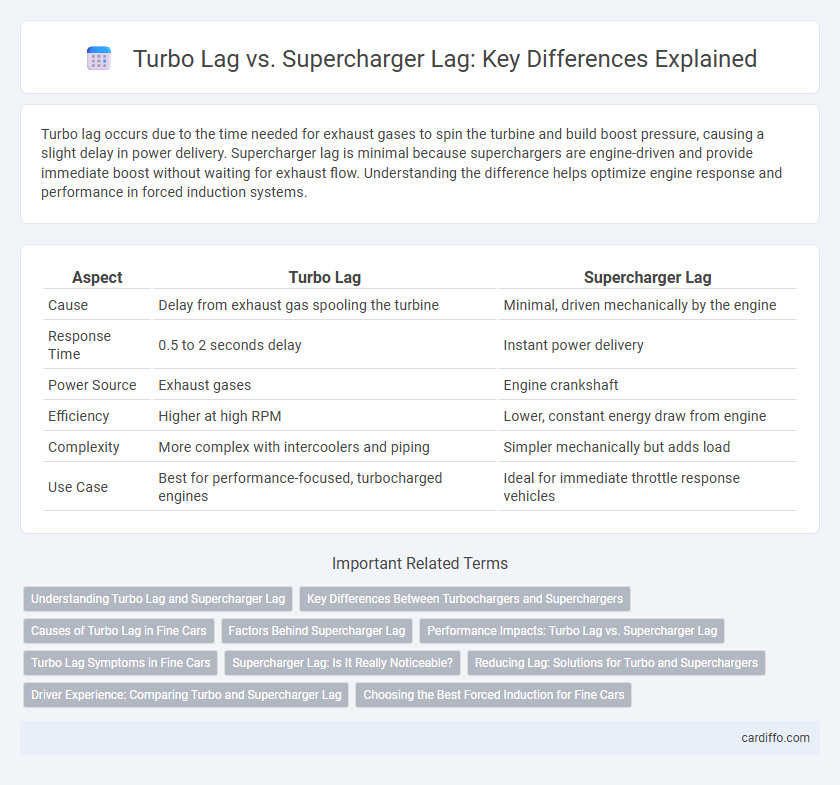Turbo lag occurs due to the time needed for exhaust gases to spin the turbine and build boost pressure, causing a slight delay in power delivery. Supercharger lag is minimal because superchargers are engine-driven and provide immediate boost without waiting for exhaust flow. Understanding the difference helps optimize engine response and performance in forced induction systems.
Table of Comparison
| Aspect | Turbo Lag | Supercharger Lag |
|---|---|---|
| Cause | Delay from exhaust gas spooling the turbine | Minimal, driven mechanically by the engine |
| Response Time | 0.5 to 2 seconds delay | Instant power delivery |
| Power Source | Exhaust gases | Engine crankshaft |
| Efficiency | Higher at high RPM | Lower, constant energy draw from engine |
| Complexity | More complex with intercoolers and piping | Simpler mechanically but adds load |
| Use Case | Best for performance-focused, turbocharged engines | Ideal for immediate throttle response vehicles |
Understanding Turbo Lag and Supercharger Lag
Turbo lag occurs due to the time needed for exhaust gases to spin the turbine and build boost pressure, causing a delay in power delivery. Supercharger lag is generally minimal since it is mechanically driven by the engine's crankshaft, providing immediate boost but can create parasitic drag. Understanding these differences helps in selecting the right forced induction system for improved engine responsiveness and performance.
Key Differences Between Turbochargers and Superchargers
Turbochargers generate power by using exhaust gases to spin a turbine, resulting in lag due to the time needed for the exhaust flow to build pressure. Superchargers, driven directly by the engine's crankshaft, provide instant boost with minimal lag but can reduce overall engine efficiency. The key difference lies in turbochargers relying on exhaust energy, causing delayed response, while superchargers deliver immediate power at the cost of increased parasitic drag.
Causes of Turbo Lag in Fine Cars
Turbo lag in fine cars primarily results from the time required for exhaust gases to spool the turbocharger's turbine, delaying boost pressure buildup. This lag often stems from the size of the turbocharger and the engine's exhaust flow characteristics, which influence the speed at which the turbine spins. Fine cars may incorporate advanced materials and precise engineering to minimize lag, but inherently rely on exhaust-driven mechanics that cause initial response delays.
Factors Behind Supercharger Lag
Supercharger lag primarily occurs due to the time required for the supercharger to build sufficient boost pressure, which depends on engine speed and load conditions. The mechanical connection between the supercharger and the engine means boost pressure generation is immediate but can feel delayed at low RPMs or rapid throttle changes. Drive belt slippage and compressor efficiency also contribute to varying levels of lag experienced with centrifugal and roots-type superchargers.
Performance Impacts: Turbo Lag vs. Supercharger Lag
Turbo lag results from the time taken for exhaust gases to spool the turbine, causing a delayed throttle response that can affect acceleration smoothness and immediate power delivery. Supercharger lag is minimal since the compressor is mechanically driven by the engine, providing near-instantaneous boost and consistent power increase. Performance-wise, turbochargers offer higher peak power and efficiency at the cost of some delay, while superchargers deliver more immediate throttle response but can reduce fuel efficiency due to constant engine load.
Turbo Lag Symptoms in Fine Cars
Turbo lag in fine cars often manifests as a delayed throttle response when accelerating, causing noticeable hesitation before the turbocharger reaches optimal boost pressure. Drivers may experience a temporary lack of power during sudden acceleration, particularly at lower RPMs, which affects smooth driving dynamics. This symptom is less common in supercharged engines, where power delivery tends to be instantaneous due to the supercharger's direct mechanical connection to the engine.
Supercharger Lag: Is It Really Noticeable?
Supercharger lag, often perceived as minimal compared to turbo lag, occurs due to the mechanical drive connection that allows instant boost delivery, but subtle delays can happen during rapid throttle changes. This lag is generally less noticeable in everyday driving because superchargers provide consistent boost without the spool-up time turbochargers require. High-performance applications might reveal minor lag during sudden power demands, but for most drivers, supercharger lag remains practically imperceptible.
Reducing Lag: Solutions for Turbo and Superchargers
Reducing turbo lag involves techniques such as variable geometry turbochargers, ball-bearing cartridges, and twin-scroll designs that improve spool-up time and airflow efficiency. Supercharger lag can be minimized by using electric superchargers or integrating blow-off valves to maintain optimal boost pressure during rapid throttle changes. Advanced engine management systems also play a critical role by precisely controlling boost levels and enhancing throttle response for both turbochargers and superchargers.
Driver Experience: Comparing Turbo and Supercharger Lag
Turbo lag often results in a noticeable delay between throttle input and power delivery due to the time required for exhaust gases to spool the turbine, impacting immediate throttle response. Superchargers deliver power instantaneously since they are mechanically driven by the engine, providing consistent boost without lag. Drivers typically experience smoother acceleration and improved throttle precision with superchargers, while turbocharged engines may require adaptation to the delay before peak torque is available.
Choosing the Best Forced Induction for Fine Cars
Turbo lag occurs due to the time needed for exhaust gases to spool the turbine, causing delayed throttle response, while supercharger lag is minimal as it is mechanically driven, providing immediate boost. In fine cars, choosing between turbochargers and superchargers depends on the desired balance between efficiency, power delivery, and driving feel, with turbochargers offering better fuel economy and top-end power, and superchargers delivering consistent low-end torque. Evaluating factors like engine tuning, vehicle intended use, and driving preferences ensures the optimal forced induction type for refined performance and smooth acceleration.
Turbo lag vs Supercharger lag Infographic

 cardiffo.com
cardiffo.com